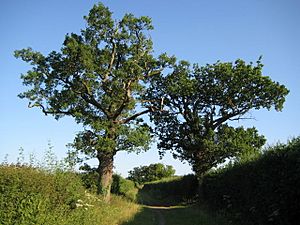Watling Chase Community Forest facts for kids
The Watling Chase Community Forest is a special green area covering about 72 square miles. It's located just north of London and in the southern part of Hertfordshire. You can find it near towns like Potters Bar, Radlett, Borehamwood, and Barnet. This forest isn't just trees; it includes many different natural spaces.
Some of the cool places within the forest are Aldenham Country Park, Scratchwood, and Moat Mount Open Space. There's also a special walking path called the Watling Chase Timberland Trail. This trail is 16 kilometres long and has signs to guide you along the way.
Contents
What is a Community Forest?
A community forest is a large area of land that is being improved for both nature and people. The Watling Chase Community Forest was started in 1991. It is one of twelve such forests across England. These forests are created to bring nature back to areas near cities and towns. They help make urban places greener and more enjoyable.
Who Manages Watling Chase?
The community forests, including Watling Chase, get support from important groups. These groups are Natural England and the Forestry Commission. They work together with local councils and volunteer groups. Their job is to look after the forest, making sure it stays healthy and welcoming for everyone. They help plant trees, create new habitats for animals, and build paths for people to explore.
Why Are Community Forests Important?
Community forests like Watling Chase play a big role in our environment. They help improve the air we breathe by having more trees. They also create homes for many different kinds of plants and animals. These forests are important green spaces where people can relax and connect with nature.
Benefits for People and Wildlife
These forests offer many benefits. They provide places for people to go for walks, cycle, or simply enjoy the outdoors. This helps people stay active and healthy. For wildlife, community forests offer safe places to live and find food. They help protect different species of birds, insects, and small mammals. By creating more green spaces, we help nature thrive even near busy cities.


